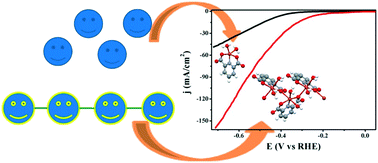Polymorphs of a copper coordination compound: interlinking active sites enhance the electrocatalytic activity of the coordination polymer compared to the coordination complex†
Abstract
Copper–pyridinedicarboxylic acid produces concomitant polymorphs, a copper complex (Cu–C) and a coordination polymer (Cu–P), which have a similar coordination environment but completely different electrocatalytic activity. Cu–P displayed highly enhanced activity for the hydrogen evolution reaction (HER, η@10 mA cm−2 = 285 mV, jmax = 161.7 mA cm−2) compared to Cu–C (η@10 mA cm−2 = 444 mV, jmax = 48.7 mA cm−2) in a neutral medium.

- This article is part of the themed collection: Editors collection: Metal Organic Frameworks as catalysts for water splitting and CO2 reduction


 Please wait while we load your content...
Please wait while we load your content...